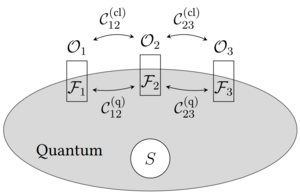III. Quantum information
Quantum technologies and quantum information are on the verge of offering an entirely new way to think about information, communications, and computing. Quantum theory requires us to completely rethink how we handle data, due to principles like the impossibility of copying unknown information. However, this challenge leads to the development of entirely new tools, such as communication systems highly resistant to espionage or computational systems with algorithmic complexities that surpass classical theory. Many platforms are being explored to implement these ideas, ranging from photonic systems in quantum optics to complex systems in condensed matter and mesoscopic physics. All of these advantages are fundamentally based on the principles of quantum theory, making it crucial to understand all aspects of this theory to fully leverage its potential.
Researchers: Giuseppe Patera, Alexandre Feller.
Driven-dissipative systems
Integrated quantum photonics combines high-density and high-performance functions on small footprint chips. In recent years, particular interest has been sparked by the possibility of exploiting the optical nonlinearities of silicon chips to generate multimode quantum states using frequency/time-like degrees of freedom. Our group has recently introduced the Bloch-Messiah analytical decomposition [Phys. Rev. Lett 125, 103601 (2020)] as a theoretical tool to decouple the complex dynamics of micro-resonators in terms of statistically independent observables that we have called morphing supermodes and to characterize their quantum properties. By applying this approach to light generated by a microresonator pumped in synchronous mode by a periodic train of pulses, we discovered [Phys. Rev. Research 5, 023178 (2023)] that traditional characterisation based on homodyne detection is incomplete because some quantum correlations (such as squeezing) remain hidden to this type of measurement. We have also studied classical solutions above threshold in CW pumping regimes and have characterized their quantum properties [Phys. Lett. A 493, 129272 (2024)]. On the other hand, ultrafast light pulses allow for studying system dynamics at ultrashort timescales and feature broad frequency comb structures used in high precision metrology. The field of ultrafast optics with coherent control techniques has flourished recently, leading to a rich toolbox for generating pulses with tailored temporal and spectral properties. Harnessing quantum features of light has driven progress in fundamental physics exploration, quantum communication, and quantum metrology.
Decoherence and the quantum-to-classical transition

The problem of the quantum-classical transition involves studying the mechanisms that degrade the quantum properties of systems, causing them to behave like classical systems. This process, known as decoherence, is an emergent phenomenon that has raised many questions since the advent of quantum theory and arises from the entanglement between the system and its environment. Understanding and controlling this phenomenon is crucial for building systems that leverage the principles of quantum physics. Despite significant theoretical and experimental progress in the study of decoherence, the quantum-classical transition problem remains unresolved.
A key missing element in the traditional approach to decoherence is the study of the observers themselves, not just the system. This is necessary to understand how a network of observers, equipped with specific resources, can access and reconstruct a common classical image—if one exists. This issue was explored by Zurek's recent work on quantum Darwinism and formalized through the tools of quantum information theory. While these results are promising, they do not provide a clear physical explanation for the existence or reconstruction of a common classical image. Research conducted within the team aims to develop a general framework to study the physics of observers, using resources that allow for precise analysis of the emergence and reconstruction of a classical description of a quantum system, making it accessible to experimental testing.
